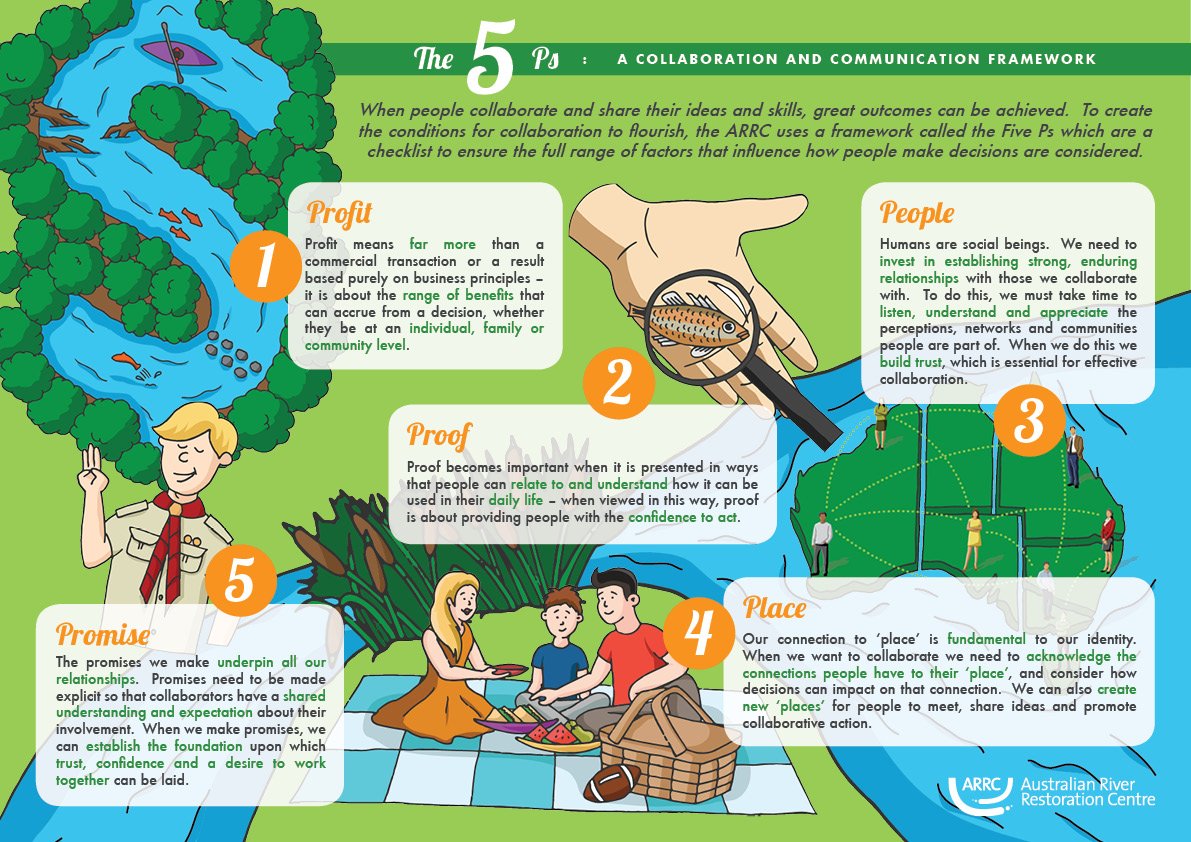Deceptively simple, highly effective – the Five Ps River Management Framework
In our Western society we place a high value on rational, logical thinking, often believing that the best decisions are those underpinned by science and technical reason. We know, however, that it is emotion that largely governs decision making. This means that for collaboration to occur and lead to great river restoration outcomes, we need to place our ‘rational’ thinking within the broader context of people’s lives. The Rivers of Carbon do this by using a framework called the Five Ps.
The Five Ps:
By using a framework called the ‘Five Ps’ it is possible to incorporate the many different factors and experiences that impact upon a person working in river restoration. It is a framework that can be applied at a number of different levels, from the individual through to an organisation.
The Five Ps stand for: Profit, Proof, People, Place and Promise and highlight the full range of factors that impact on natural resources management decision making.
- Profit – highlighting the multiple benefits that can be achieved through river restoration (shelter, beneficial wildlife, living haystack, firewood, improved water quality, lovely place to spend time)
- Proof – the role of science in providing confidence to act (many years of scientific research and practical testing brought together in real-life situations)
- People – valuing the experience and knowledge we all bring, and sharing what we know (taking time to build relationships, listen to each other and develop mutual respect)
- Place – recognising and acknowledging our connection to country (acknowledging our ‘places’ as part of our identity, recognition we are often custodians of a place to be handed to the next generation)
- Promise – basing our relationships on trust, mutual respect and a discussion about expectations (realistic, respectful and lasting relationships)
When you pause and reflect on what each of these Five Ps mean for your project or activity, you end up running through a process that ensures social, economic and environmental factors are covered in an easy and intuitive way.
RoCking the Five Ps:
Rivers of Carbon uses the Five Ps throughout all its projects, activities and events, as we believe that river restoration and management is as much a social, as an environmental issue. If we fail to recognise the value of people and just focus on ‘fixing’ a problem with technical solutions, we will ultimately fail in our river restoration efforts. This is because we need people to own and connect to our river restoration and management efforts so that the ‘fixes’ we propose, can support the longer term behavioural and land-use change that we need for our riverine communities to survive and thrive.
Within the Five Ps are some simple steps for protecting and restoring rivers that we use to guide our discussions with landholders. These steps are:
- Protect first, restore second
- Prioritise high recovery trajectory sites (best bang for buck)
- Connect to remnant vegetation
- Allow and accept that the river needs to move
- Remove stock, stabilise, revegetate and manage weeds
- Give nature time to heal, and trust in that process
- Seek support and inspiration from others
You can find out more about how we manage riparian zones for multiple benefits by following this link.
How do we monitor and evaluate the Five Ps? Follow this link to find out.
Use the Five Ps for yourself:
The infographic below explains each of the Five Ps in detail so that you can see how we use it in our day-to-day work and life. You are very welcome to download the infographic and use it in your own work to promote collaborative action. Please share it with others, and adapt and modify it to suit your needs.
What do people think about the Five Ps?
Professor Ian Rutherfurd provided this comment after seeing the Rivers of Carbon program ‘in action’ and the Five Ps being used.
There are many agencies and groups doing stream restoration activities in Australia and internationally. And the activities that Rivers of Carbon do on the ground are not surprising: riparian revegetation, restoring connectivity for fish, training communities and so on. But what is fundamentally different is their delivery model (or business model if you like). They essentially package resources from different sources, and then deliver those in a unique way (and I use the word unique deliberately).
Their five Ps program (profit, proof, people, place, and promise) is a beautiful summary of the philosophy here. Their focus on the needs and perspectives of the communities they work is the key to their success. They have leveraged the idea of river corridors as rivers of carbon as a starting point for their program, but have built out to even more sophisticated approaches. You can see that the foundation of their work is to unlock the values of rivers and riparian areas – whether that value is carbon, organisms, shade, or spiritual well-being. This approach has great application internationally.
The success of the program is greatly influenced by the tireless efforts of the Director Dr Siwan Lovett. I have known Siwan for many years, and could not think of a more dedicated advocate for rivers and wetlands. Central to her success is her clear philosophy that managing landscapes is about managing relationships. She helps her communities to see themselves, and the aquatic systems that they care about, as part of that same community. She has espoused this philosophy effectively and persuasively at every opportunity, and it has succeeded in changing the way both professionals and individuals across Australia see their restoration mission.
I have seen the Rivers of Carbon program in action on the ground, and it has been an inspiring experience.
Professor Ian Rutherfurd has been inspiring waterway managers in his presentations and research over many years, he is part of the University of Melbourne’s School of Geography
Give it a go and try using the Five Ps 🙂

